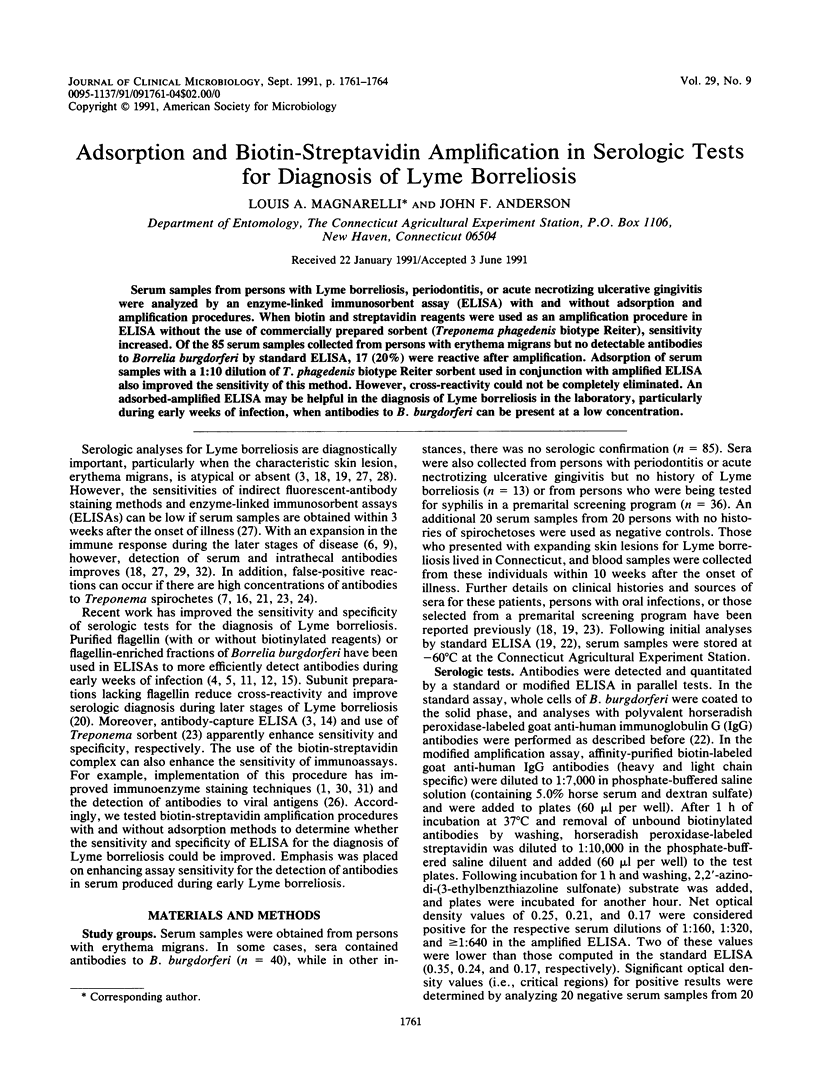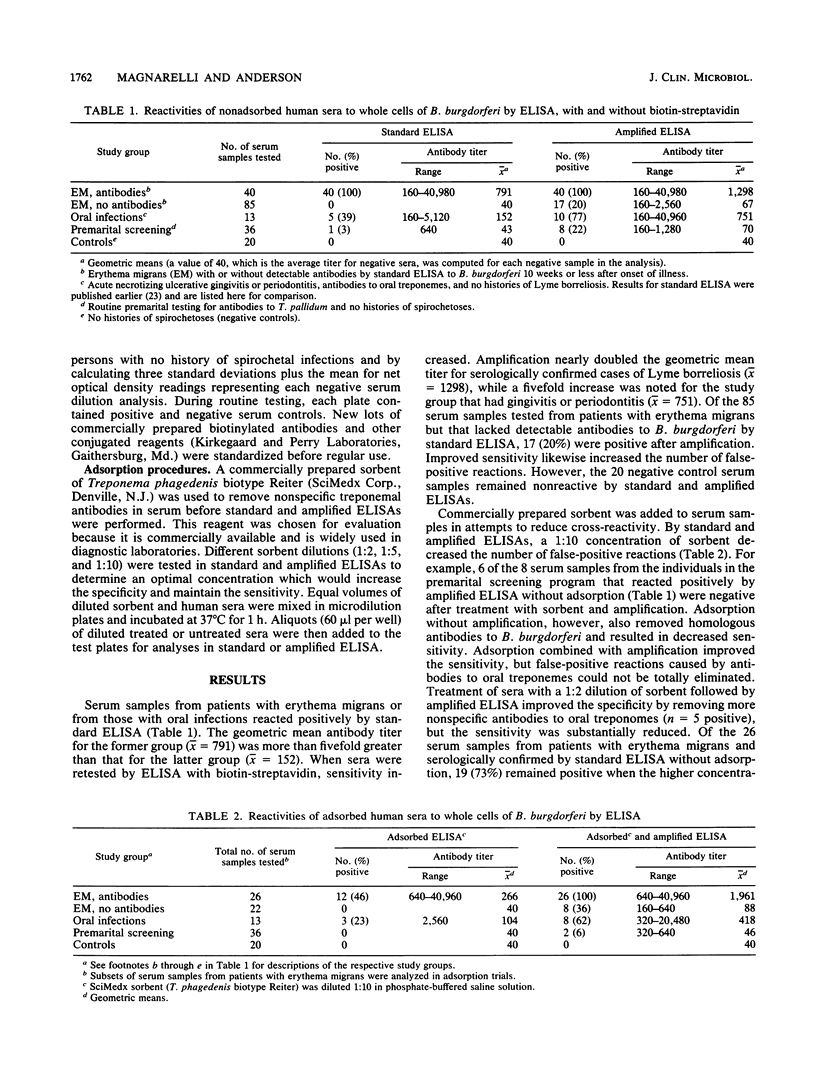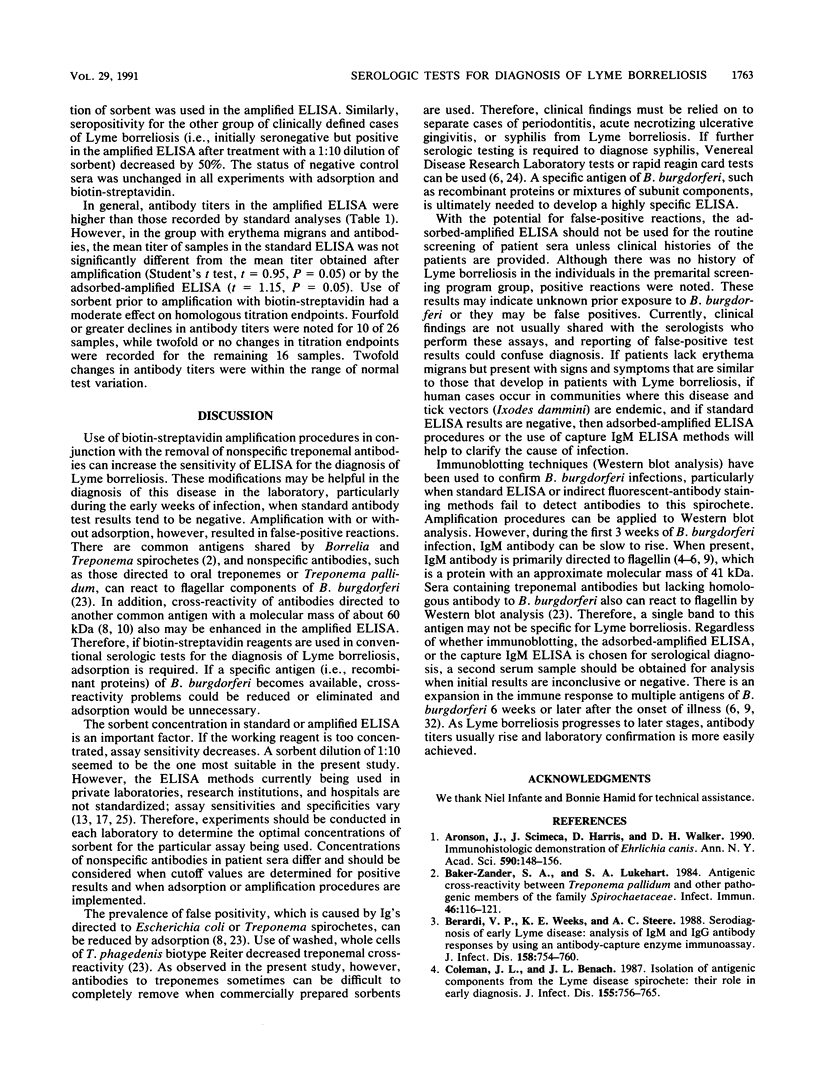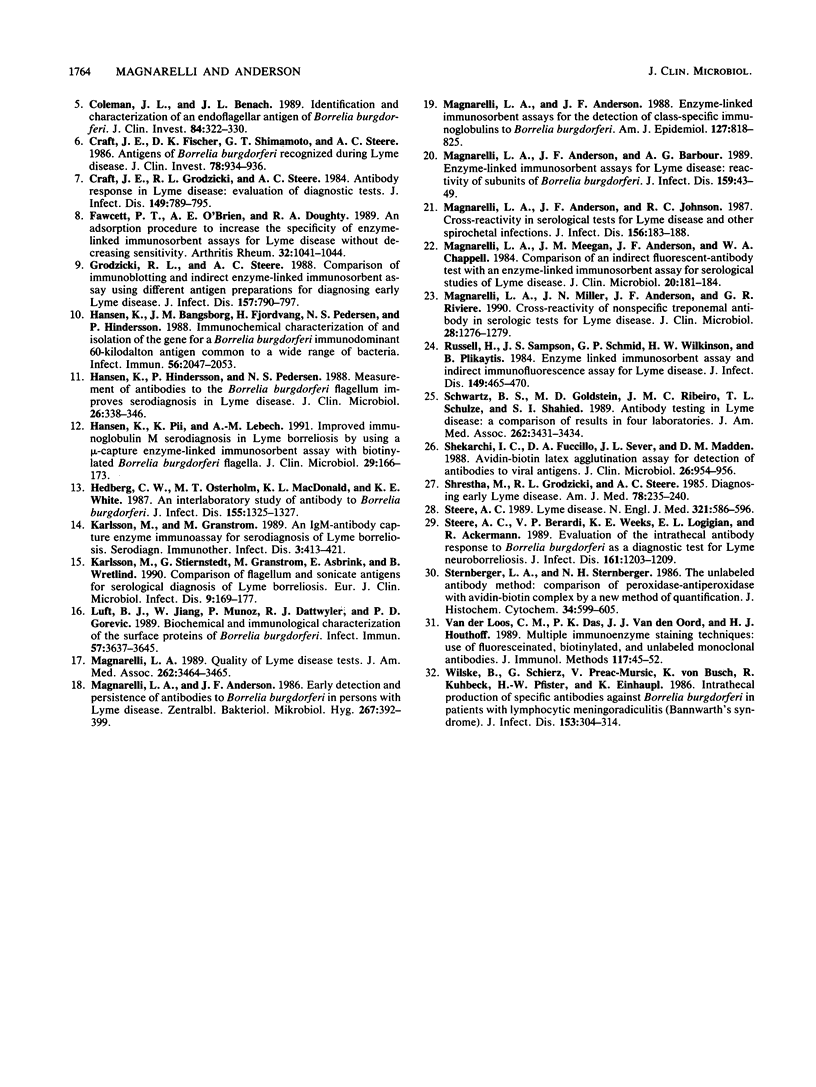Abstract
Serum samples from persons with Lyme borreliosis, periodontitis, or acute necrotizing ulcerative gingivitis were analyzed by an enzyme-linked immunosorbent assay (ELISA) with and without adsorption and amplification procedures. When biotin and streptavidin reagents were used as an amplification procedure in ELISA without the use of commercially prepared sorbent (Treponema phagedenis biotype Reiter), sensitivity increased. Of the 85 serum samples collected from persons with erythema migrans but no detectable antibodies to Borrelia burgdorferi by standard ELISA, 17 (20%) were reactive after amplification. Adsorption of serum samples with a 1:10 dilution of T. phagedenis biotype Reiter sorbent used in conjunction with amplified ELISA also improved the sensitivity of this method. However, cross-reactivity could not be completely eliminated. An adsorbed-amplified ELISA may be helpful in the diagnosis of Lyme borreliosis in the laboratory, particularly during early weeks of infection, when antibodies to B. burgdorferi can be present at a low concentration.
Full text
PDF



Selected References
These references are in PubMed. This may not be the complete list of references from this article.
- Aronson J., Scimeca J., Harris D., Walker D. H. Immunohistologic demonstration of Ehrlichia canis. Ann N Y Acad Sci. 1990;590:148–156. doi: 10.1111/j.1749-6632.1990.tb42217.x. [DOI] [PubMed] [Google Scholar]
- Baker-Zander S. A., Lukehart S. A. Antigenic cross-reactivity between Treponema pallidum and other pathogenic members of the family Spirochaetaceae. Infect Immun. 1984 Oct;46(1):116–121. doi: 10.1128/iai.46.1.116-121.1984. [DOI] [PMC free article] [PubMed] [Google Scholar]
- Berardi V. P., Weeks K. E., Steere A. C. Serodiagnosis of early Lyme disease: analysis of IgM and IgG antibody responses by using an antibody-capture enzyme immunoassay. J Infect Dis. 1988 Oct;158(4):754–760. doi: 10.1093/infdis/158.4.754. [DOI] [PubMed] [Google Scholar]
- Coleman J. L., Benach J. L. Identification and characterization of an endoflagellar antigen of Borrelia burgdorferi. J Clin Invest. 1989 Jul;84(1):322–330. doi: 10.1172/JCI114157. [DOI] [PMC free article] [PubMed] [Google Scholar]
- Coleman J. L., Benach J. L. Isolation of antigenic components from the Lyme disease spirochete: their role in early diagnosis. J Infect Dis. 1987 Apr;155(4):756–765. doi: 10.1093/infdis/155.4.756. [DOI] [PubMed] [Google Scholar]
- Craft J. E., Fischer D. K., Shimamoto G. T., Steere A. C. Antigens of Borrelia burgdorferi recognized during Lyme disease. Appearance of a new immunoglobulin M response and expansion of the immunoglobulin G response late in the illness. J Clin Invest. 1986 Oct;78(4):934–939. doi: 10.1172/JCI112683. [DOI] [PMC free article] [PubMed] [Google Scholar]
- Craft J. E., Grodzicki R. L., Steere A. C. Antibody response in Lyme disease: evaluation of diagnostic tests. J Infect Dis. 1984 May;149(5):789–795. doi: 10.1093/infdis/149.5.789. [DOI] [PubMed] [Google Scholar]
- Fawcett P. T., O'Brien A. E., Doughty R. A. An adsorption procedure to increase the specificity of enzyme-linked immunosorbent assays for Lyme disease without decreasing sensitivity. Arthritis Rheum. 1989 Aug;32(8):1041–1044. doi: 10.1002/anr.1780320814. [DOI] [PubMed] [Google Scholar]
- Grodzicki R. L., Steere A. C. Comparison of immunoblotting and indirect enzyme-linked immunosorbent assay using different antigen preparations for diagnosing early Lyme disease. J Infect Dis. 1988 Apr;157(4):790–797. doi: 10.1093/infdis/157.4.790. [DOI] [PubMed] [Google Scholar]
- Hansen K., Bangsborg J. M., Fjordvang H., Pedersen N. S., Hindersson P. Immunochemical characterization of and isolation of the gene for a Borrelia burgdorferi immunodominant 60-kilodalton antigen common to a wide range of bacteria. Infect Immun. 1988 Aug;56(8):2047–2053. doi: 10.1128/iai.56.8.2047-2053.1988. [DOI] [PMC free article] [PubMed] [Google Scholar]
- Hansen K., Hindersson P., Pedersen N. S. Measurement of antibodies to the Borrelia burgdorferi flagellum improves serodiagnosis in Lyme disease. J Clin Microbiol. 1988 Feb;26(2):338–346. doi: 10.1128/jcm.26.2.338-346.1988. [DOI] [PMC free article] [PubMed] [Google Scholar]
- Hansen K., Pii K., Lebech A. M. Improved immunoglobulin M serodiagnosis in Lyme borreliosis by using a mu-capture enzyme-linked immunosorbent assay with biotinylated Borrelia burgdorferi flagella. J Clin Microbiol. 1991 Jan;29(1):166–173. doi: 10.1128/jcm.29.1.166-173.1991. [DOI] [PMC free article] [PubMed] [Google Scholar]
- Hedberg C. W., Osterholm M. T., MacDonald K. L., White K. E. An interlaboratory study of antibody to Borrelia burgdorferi. J Infect Dis. 1987 Jun;155(6):1325–1327. doi: 10.1093/infdis/155.6.1325. [DOI] [PubMed] [Google Scholar]
- Karlsson M., Stiernstedt G., Granström M., Asbrink E., Wretlind B. Comparison of flagellum and sonicate antigens for serological diagnosis of Lyme borreliosis. Eur J Clin Microbiol Infect Dis. 1990 Mar;9(3):169–177. doi: 10.1007/BF01963833. [DOI] [PubMed] [Google Scholar]
- Luft B. J., Jiang W., Munoz P., Dattwyler R. J., Gorevic P. D. Biochemical and immunological characterization of the surface proteins of Borrelia burgdorferi. Infect Immun. 1989 Nov;57(11):3637–3645. doi: 10.1128/iai.57.11.3637-3645.1989. [DOI] [PMC free article] [PubMed] [Google Scholar]
- Magnarelli L. A., Anderson J. F., Barbour A. G. Enzyme-linked immunosorbent assays for Lyme disease: reactivity of subunits of Borrelia burgdorferi. J Infect Dis. 1989 Jan;159(1):43–49. doi: 10.1093/infdis/159.1.43. [DOI] [PubMed] [Google Scholar]
- Magnarelli L. A., Anderson J. F. Enzyme-linked immunosorbent assays for the detection of class-specific immunoglobulins to Borrelia burgdorferi. Am J Epidemiol. 1988 Apr;127(4):818–825. doi: 10.1093/oxfordjournals.aje.a114864. [DOI] [PubMed] [Google Scholar]
- Magnarelli L. A., Anderson J. F., Johnson R. C. Cross-reactivity in serological tests for Lyme disease and other spirochetal infections. J Infect Dis. 1987 Jul;156(1):183–188. doi: 10.1093/infdis/156.1.183. [DOI] [PubMed] [Google Scholar]
- Magnarelli L. A., Meegan J. M., Anderson J. F., Chappell W. A. Comparison of an indirect fluorescent-antibody test with an enzyme-linked immunosorbent assay for serological studies of Lyme disease. J Clin Microbiol. 1984 Aug;20(2):181–184. doi: 10.1128/jcm.20.2.181-184.1984. [DOI] [PMC free article] [PubMed] [Google Scholar]
- Magnarelli L. A., Miller J. N., Anderson J. F., Riviere G. R. Cross-reactivity of nonspecific treponemal antibody in serologic tests for Lyme disease. J Clin Microbiol. 1990 Jun;28(6):1276–1279. doi: 10.1128/jcm.28.6.1276-1279.1990. [DOI] [PMC free article] [PubMed] [Google Scholar]
- Magnarelli L. A. Quality of Lyme disease tests. JAMA. 1989 Dec 22;262(24):3464–3465. [PubMed] [Google Scholar]
- Russell H., Sampson J. S., Schmid G. P., Wilkinson H. W., Plikaytis B. Enzyme-linked immunosorbent assay and indirect immunofluorescence assay for Lyme disease. J Infect Dis. 1984 Mar;149(3):465–470. doi: 10.1093/infdis/149.3.465. [DOI] [PubMed] [Google Scholar]
- Schwartz B. S., Goldstein M. D., Ribeiro J. M., Schulze T. L., Shahied S. I. Antibody testing in Lyme disease. A comparison of results in four laboratories. JAMA. 1989 Dec 22;262(24):3431–3434. [PubMed] [Google Scholar]
- Shekarchi I. C., Fuccillo D. A., Sever J. L., Madden D. M. Avidin-biotin latex agglutination assay for detection of antibodies to viral antigens. J Clin Microbiol. 1988 May;26(5):954–956. doi: 10.1128/jcm.26.5.954-956.1988. [DOI] [PMC free article] [PubMed] [Google Scholar]
- Shrestha M., Grodzicki R. L., Steere A. C. Diagnosing early Lyme disease. Am J Med. 1985 Feb;78(2):235–240. doi: 10.1016/0002-9343(85)90432-2. [DOI] [PubMed] [Google Scholar]
- Steere A. C., Berardi V. P., Weeks K. E., Logigian E. L., Ackermann R. Evaluation of the intrathecal antibody response to Borrelia burgdorferi as a diagnostic test for Lyme neuroborreliosis. J Infect Dis. 1990 Jun;161(6):1203–1209. doi: 10.1093/infdis/161.6.1203. [DOI] [PubMed] [Google Scholar]
- Steere A. C. Lyme disease. N Engl J Med. 1989 Aug 31;321(9):586–596. doi: 10.1056/NEJM198908313210906. [DOI] [PubMed] [Google Scholar]
- Sternberger L. A., Sternberger N. H. The unlabeled antibody method: comparison of peroxidase-antiperoxidase with avidin-biotin complex by a new method of quantification. J Histochem Cytochem. 1986 May;34(5):599–605. doi: 10.1177/34.5.3517144. [DOI] [PubMed] [Google Scholar]
- Van der Loos C. M., Das P. K., Van den Oord J. J., Houthoff H. J. Multiple immunoenzyme staining techniques. Use of fluoresceinated, biotinylated and unlabelled monoclonal antibodies. J Immunol Methods. 1989 Feb 8;117(1):45–52. doi: 10.1016/0022-1759(89)90117-8. [DOI] [PubMed] [Google Scholar]
- Wilske B., Schierz G., Preac-Mursic V., von Busch K., Kühbeck R., Pfister H. W., Einhäupl K. Intrathecal production of specific antibodies against Borrelia burgdorferi in patients with lymphocytic meningoradiculitis (Bannwarth's syndrome). J Infect Dis. 1986 Feb;153(2):304–314. doi: 10.1093/infdis/153.2.304. [DOI] [PubMed] [Google Scholar]


